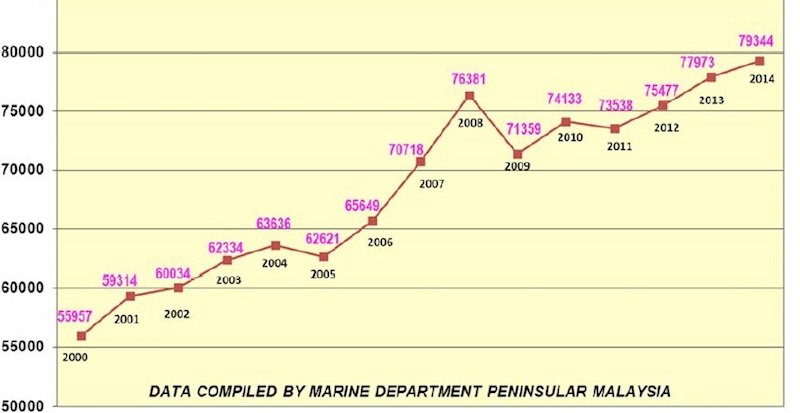According to a study compiled by the Nippon Maritime Center using data from the Marine Department of Malaysia’s STRAITREP system there were 79,344 transits of the Strait by vessels over 300 gt between One Fathom Bank to the north and Iyu Kecil to the south. On average 217 vessels per day transited the waterway in 2014, up from 201 in 2011.
According to the report the largest users of the Strait are containerships, although it is the VLCCs, bulk carriers and LNG/LPG traffic where the most growth is being seen.
Containerships account for 33% of the traffic in the strait with 25,071 in 2014, up slightly from 24,658 in the previous year. However, this number is well below the all time high for boxships of 26,359 transits in 2008.
This has been influenced by the increased size of containerships. “The container traffic reports have been affected by a growing number of ultra large containerships being brought into service, with lesser ships carrying more containers on respective trade routes,” the report noted.
Demand for oil has driven an almost consistent growth in VLCC tanker traffic since 2000. Last year this trend continued with 4,993 VLCC transits, compared to 4,285 in the previous. “Since 2007, an average year-on-year growth of 4.7% in VLCC traffic reports is seen, averaging between 11 to 15 VLCC daily transit reports in both directions of Malacca Straits,” the Nippon Maritime Center said.
Similarly bulk carrier transits have risen steadily since 2000, excluding 2011driven by East Asia’s demand for raw materials and commodities, in particular from China. Last year there were 13,454 bulk carrier transits of the Strait compared to just 4,708 some 15 years earlier in 2000.
LNG and LPG carrier transits have also risen dramatically since 2009, and now account for 5% of all traffic. However, the number of transits took a slight dip last year to 4,173 compared to 4,248 in 2013. “This could be due to LNG ships increasingly taking the transpacific route, for example from US, Canada and Australia,” the report noted.
Car carrier transits, which dropped sharply in 2009 as the global economic crisis took a hold, are continuing to rise but are still not back at 2008 levels. In 2014 there were 3,146 car carrier transits of the waterway, compared to 3,455 in 2008.

Malacca Strait vessel transits 2000 - 2014
Copyright © 2024. All rights reserved. Seatrade, a trading name of Informa Markets (UK) Limited.
Add Seatrade Maritime News to your Google News feed.  |

